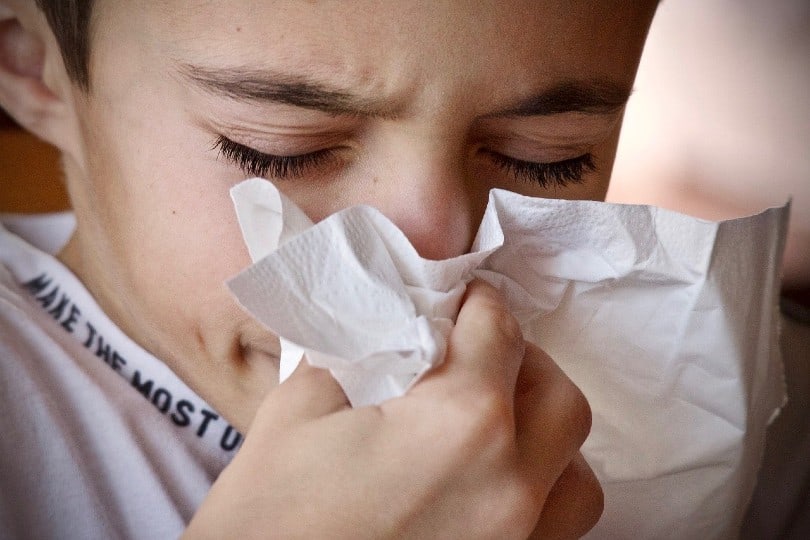Whether you already have children and are considering adding a cat to your family, or you already have cats and are expecting a baby your main concern is going to be the safety of your children. Any pet, including cats, can pose a potential danger to babies and children, but there are many cat-owning households with little ones that have no trouble at all. Let’s look into what kind of potential risks exist regarding cats around children and how to ensure the health and safety of everyone.
Cats and Children: The Health and Safety Risks
The truth is, there are risks of danger all around us, even in the safety of our homes. The best way to prevent accidents and keep everyone as safe as possible is to be aware of what kind of potential dangers surround us and how to best avoid them.
When it comes to cat ownership, there are some potential risks involved but with proper precautionary measures, you can certainly minimize the risk.
Scratches and Bites
Undoubtedly the most common issue that cat owners with children will face is the risk of scratches and bites. Cats and children typically have no problem living happily and safely together but that can be dependent on how the children treat and handle the cat and the cat’s overall temperament.
Getting scratched or bitten by a cat is no fun, any open wound is at risk of becoming infected, so it’s important to properly clean any wound, especially those that result in broken skin. There is also the risk of cat scratch disease, which is a bacterial infection that is spread when an infected cat either scratches or bites a person to break the skin or if they were to lick a person’s open wound.
Allergies
Cat allergies are twice as common as dog allergies and up to 10 percent of the population in the United States is reported to suffer from some form of pet allergy. While allergies can be more of a nuisance, in more severe cases they can lead to allergic asthma, where the airway tightens when the allergen is inhaled.
If your child were to show any symptoms of allergies, it’s best to have them tested by an allergist to be certain of the specific allergens, as it may not be the cat after all. Once you determine the source of the allergy, you can work with the physician to come up with the best game plan for your health.

Zoonotic Disease and Parasites
There are a variety of infectious diseases that cats can carry and pass onto people, these are known as zoonotic diseases. These diseases are typically spread by contact with feces, something contaminated with the feces, or through biting or scratching. Some parasites can be passed along to humans from cats.
For the most part, the transmission of these diseases and parasites is rare, but it’s best to always take precautions, keep up on regular veterinary care, and practice proper husbandry and cleanliness. Here’s a list of some of the zoonotic diseases and parasites that can be spread from cats:
- Toxoplasmosis
- Salmonella
- Campylobacter
- Cat Scratch Disease
- Giardia
- Cryptosporidium
- Ringworm
- Hookworm
- Tapeworm
Risk of Infant Suffocation (Rare)
You may have heard of the old urban legend that cats would “steal baby’s breath.” It’s important to dispel that myth once and for all, as cats are not malicious and do not kill infants with any form of intent. Your cat can pose a risk of accidental suffocation to an infant if they are allowed to sleep together.
This is the same reason why parents are instructed specifically not to co-sleep with their infants, as newborns and young infants do have proper head control and can easily suffocate if stuck in a position that has blocked their breathing.
While it is a very rare occurrence for a pet cat to accidentally suffocate an infant, it’s still vitally important that you take proper precautions to ensure there are no suffocation risks to your infant, whether it be related to household pets, people, bedding, or anything else.
How to Keep Children Safe Around Cats
There are many different things you can do to minimize any potential danger that cats could pose around children and infants. Many, many families live safely and happily with children and cats.
- Starting at a very young age, teach children how to properly handle and behave around any pets. Always make sure you supervise children when they are near the household pets to ensure the safety of both the child and the animal.
- Avoid rough play with your cat(s). Even when it’s an innocent and fun play, it could still result in accidental bites or scratches.
- Always make sure to wash your hands carefully after handling the cat or any of the cat-related items such as the litter, the litter box, food and water bowls, bedding, etc.
- Make sure to wash all bites and scratches with soap and water immediately and make sure to keep up with proper wound care to prevent infection.
- Keep your cat well-groomed and consider trimming their claws to help protect against scratches.
- If you suspect allergies, get proper testing and diagnosis by an allergist and seek treatment options.
- Keep up with preventative care to control parasites such as fleas, ticks, and various worms.
- Keep your cat up to date with all necessary vaccinations.
- Speak to your veterinarian regarding any concerns you have about zoonotic diseases or parasites or any other risks you need more information about.
Conclusion
Having a cat around children isn’t always dangerous in an obvious way. Cats pose the risk of causing allergies in children or transmitting parasites to them. Cats may also scratch and bite children if they feel threatened. It’s important to teach your child how to behave around your cat to prevent this from happening. Keeping your cat up to date on vaccines and health checks can also reduce some of the risk.
Featured Image Credit: Pixabay














